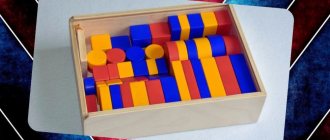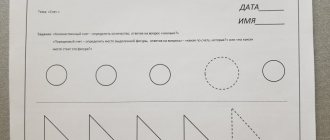Middle group. Junior preschool age. Children 4 - 5 years old
Card index of games on eidetics for children of the middle group Eidetics is a branch of psychology that studies eidetism as a type of figurative memory and the possibility of its practical application in different spheres of human life. Eidetics uses all the child’s analyzers: it allows not only to see, but also to touch, hear,...
Card index of games for speech development in the middle group using the Pop It toy Card index of games for speech development in the middle group using the Pop It toy. No. 1Game “If you hear the word”
Goal: To develop auditory perception, speech hearing. Progress of the game: Option 1: The teacher pronounces the words. Assignment: children press a blue circle if they hear...
Concept
A card index is a record of documents arranged in alphabetical order. There may also be a distribution by deadlines and topics. Thanks to the fact that everything is located in one department of the enterprise, finding any information will not be difficult.
What is a card index in a library? These are catalogs that allow you to quickly find books of interest, because all readers come to receive specific information. Without them, it would be difficult to navigate any library.
The meaning of the word "card index"
This term was coined by the ancient Greeks. Translated from their language, it meant “a place for storing sheets of papyrus.” Over the millennia that have passed since then, the semantics of the word “card file” has not changed much. And today this is the name given to a collection of cards with data laid out in a certain order.
The purpose of filing cabinets is to preserve and organize information. And also make it easier to find. Therefore, the cards are arranged according to the selected criterion. Most often in alphabetical order. Less often - by year, address, number, topic, last name, etc.
Also, a filing cabinet is also specialized furniture for storing the above-mentioned collections. Sometimes this is the name given to the room or department where they are located.
In fact, over the millennia since the emergence of this concept, only the material of the cards has changed in its structure and meaning from papyrus to cardboard.
Medical databases
If, with the advent of electronic books, people go to the library much less often, preferring to download everything and read on a computer, then a medical file is something that one has to deal with against one’s own will.
In any medical institution (no matter public or private), each patient has his own card. It stores all the secrets about his health (symptoms, test results, treatment, doctor’s orders, extracts from the medical history).
It is interesting that although all these “cards” are in practice more like brochures or small books, they continue to bear their traditional name. The thing is, this system initially really consisted of cardboard cards with data, after which this document is named.
Like all other filing systems, medicine is now widely computerized in more developed countries. We are still just getting there. However, there are already several programs adapted to our realities for maintaining a database of patients, recording the services provided to them in hospitals, clinics and other medical institutions. True, they are specialized for paid clinics, where they are used most often.
Card file of arbitration cases
The judicial system has mastered new trends much faster than the medical system. At the moment, in most countries of the world, computer databases are being created that contain information on cases that are or have been before arbitration courts of all levels and entities.
In the Russian Federation this is the Card Index of Arbitration Cases. It is a website kad.arbitr.ru, where, using various search parameters, you can find all the necessary data about the court decision, if for some reason they are not classified. This resource inherited its name from a system used in the pre-computer era. While in the same Ukraine, a site with such data is called not a “card index”, but a “register” (“Unified State Register of Ship Decisions”).
And also about the law enforcement system. As is known, from the moment of its formation, all countries of the world began to keep records of persons who had previously committed crimes or were suspected of them.
Today, all this information is no longer stored in dusty folders, but has been digitized and entered into computer databases.
In the Russian Federation, the “Card Index” program has been developed to store information from the forensic expert department of the Ministry of Internal Affairs and about registered persons. We can assume that its name is another way of interpreting the term in question.
Library
The literature card file occupies an important place in an educational institution. Readers receive information about it thanks to:
- visual information;
- events, conversations, excursions;
- days of bibliography;
- publication of manuals;
- use of forms and methods of library activities.
The system of catalogs and cards in the library is managed through planning, coordination, and control. The work of employees in this area consists of drawing up plans, developing documentation, and monitoring completed activities. Each library card is subject to maintenance and editing, for which employees are responsible according to their job description.
Banking industry
What is a card index in a bank? This term implies accounting for payment documents that the bank has not fulfilled. The institution keeps them under control. The file cabinet can be of different types, depending on the reasons for unpaid obligations.
These may be orders that were not executed due to lack of funds. Then the employee registers the document in electronic and paper form. This payment will be in an off-balance sheet account. The account owner is informed that the document has been queued. Once received, the funds are credited to the desired account. The file cabinet stores documents that require consent to perform a payment transaction, as well as those that are awaiting their turn.
The presence of a file cabinet indicates that the company has an unstable financial position. If the account owner does not have it, then the bank offers a line of credit or an additional one. financing.
The sequence is the order in which payment orders are executed. It is approved by law. Documents are not processed ahead of the queue. If the account has the required amount, then everything goes by date. If the necessary funds are not available, the following queue is established:
- execution of orders for damage compensation;
- payment of salaries, sick leave, vacations;
- tax payments;
- sending money to funds;
- other requirements.
Features of filing cabinets in hospitals
The filing cards include essential patient information. There you can find information about your health status, medical history, and prescribed medications. The document allows you to transfer data from one doctor to another.
Cards are stored on special racks, where everything is arranged in alphabetical order. Furniture for documentation can be ordered to specific sizes. The racks have a depth of 18-25 cm and a width of 1000 mm. Many companies manufacture custom-made furniture based on customer preferences.
There is mobile rail furniture for the archive department. It will help compactly place the necessary materials in small areas. The reception area may have stationary shelving or combined furniture. Properly placed documentation will allow you to quickly find the card you need.
Directory types
The card file includes many catalogs, which may differ in purpose, coverage of the fund, grouping method, technology of creation and use.
If we consider the purpose, then catalogs are for readers and for service purposes. They contain, for example, information of interest to readers. Based on the coverage of collections, catalogs can include useful information about institutions, as well as about specific library departments.
According to the grouping method, cards are:
- alphabetical;
- systematic.
The first is presented in the form of a catalog where the data is listed in alphabetical order. To quickly find the book you need, you need to find the author's name or the title of the work. Using such a catalog is very convenient.
A systematic catalog is a catalog in which information is located by field of knowledge. For this purpose, the principles of library and bibliographic classification are used, which prescribe the rules for grouping information. Considering the type of creation and use, file cabinets can be traditional or electronic.
Document storage rules
The archive is maintained by a special employee who works on the basis of a job description. The employee ensures the reception, recording and storage of documentation. It carries out information and reference activities, as well as organizational and methodological ones.
At each enterprise, the archive is located in a separate room. Only as an exception, racks, cabinets, and safes are used that perform the function of preserving documentation. Their shelf life is determined to be 3 years, but it can be reduced.
After this period has expired, it is determined whether the document will be used or archived forever. There is also a destruction option. What exactly needs to be done is decided on the basis of an expert commission.
Card index of didactic games by age (middle, high, preparatory)
Victoria Kladko
Card index of didactic games by age (middle, high, preparatory)
This material will be useful to preschool teachers. The card index contains all groups of didactic games for each age.
Didactic games
Preschool childhood is a period of play. At this age, the child strives to learn everything through play. The game is a reflection by children of the adult, real world. It contains great opportunities for teaching children in preschool institutions. In a didactic game, cognitive tasks are combined with gaming ones. Through play, in particular didactic games, a child learns while playing. A didactic game, as one of the diverse games of a preschooler, is an effective means of shaping the personality of a preschooler, his moral and volitional qualities; it realizes the need to influence the world. Thanks to didactic games, the child develops independence, the ability to complete a task started, self-control, children learn to interact in a team, they develop a sense of mutual assistance (competition games, board-printed games in which several children can take part, for example, “Collect picture", "Puzzles", "Loto", "Dominoes", etc., learn to accept defeat and victory in games with dignity. Properly used didactic games help develop perseverance in children, the ability to inhibit their feelings and desires, and obey the rules.
The question of the classification of didactic games is extremely important and controversial.
Based on the nature of the material used, didactic games are divided into three groups:
Games with objects are based on children’s direct perception and correspond to the child’s desire to act with objects and thus become familiar with them. In games with objects, children learn to compare, establish similarities and differences between objects. The value of these games is that with their help children become familiar with the properties of objects, size, and color. When introducing children to nature in such games, I use natural materials (plant seeds, leaves, pebbles, various flowers, pine cones, twigs, vegetables, fruits, etc. - which arouses keen interest and an active desire in children to play. Examples of such games: “Don’t make a mistake”, “Describe this object”, “What is it?”, “What comes first, what comes next”, etc.
Board and printed games are an interesting activity for children to get acquainted with the world around them, the world of animals and plants, and phenomena of living and inanimate nature. They are varied in type: “lotto”, “dominoes”, paired pictures.” With the help of board and printed games, you can successfully develop speech skills, mathematical abilities, logic, attention, learn to model life patterns and make decisions, and develop self-control skills.
Word games are an effective method of fostering independent thinking and speech development in children. They are built on the words and actions of the players; children independently solve various mental problems: they describe objects, highlighting their characteristic features, guess them from the description, find similarities and differences between these objects and natural phenomena.
Card index of didactic games
Middle group.
“Paired pictures” (Desktop-printed)
Goal: To teach children to compare objects, find signs of similarity, enrich their vocabulary.
Progress: Finding the necessary cards and making a pair of them. The teacher invites the children to play “Paired Pictures”. Shows game material, explains the rules, and collects the first paired picture as an example.
“Guess who called?” (Verbal)
Goal: Development of auditory attention, orientation in space.
Procedure: According to the counting, a driver is chosen, who stands in the center of the circle, blindfolded. The rest of the children call him at will, and the driver knows by his voice who called him.
“Wonderful bag” (With objects)
Goal: To teach children to recognize objects by their characteristic features.
Procedure: Children take turns approaching the teacher and putting their hand into the bag, then the child, without taking the object out of the bag, names it.
Senior group
“What’s extra?” (Desktop-printed)
Goal: To develop observation and logic.
Progress: The teacher invites the children to look at pictures with images. The child looks at pictures of objects and names the extra object. Then, children must explain their choice.
“We won’t tell you where we were, but we’ll show you what we did” (Verbal)
Goal: To teach children to identify the characteristic features of an action and depict the action itself with their help; teach children to recognize the meaning of the depicted action through pantomime.
Progress: The driver asks questions, the other children, without resorting to words, depict some action, and the driver guesses it.
“Similar - not similar” (With objects)
Goal: To teach children to compare objects, to notice signs of similarity in color, shape, size, material; develop observation and thinking skills.
Progress: The teacher prepares various items in advance and quietly places them in the room. The child finds two objects in the group that are similar in his opinion and explains their similarity.
Preparatory group
"Puzzles" (Desktop-printed)
Goal: To develop the ability to compare, generalize, and correctly name an object.
Progress: The child assembles a whole image from mixed pieces
“Choose a word” (Verbal)
Goal: Develop thinking and logic.
Progress : The teacher names pre-planned words. Children give answers by choosing words that match their meaning.
“Edible – inedible” (With objects)
Goal: To develop attention and the ability to separate objects into two categories.
Progress: The driver names the objects, and the rest of the children divide them into two categories - edible and inedible.
To summarize, we can say that didactic games are an indispensable means of raising and teaching children.





